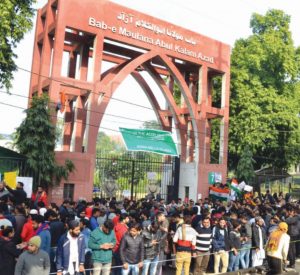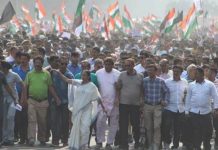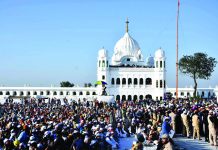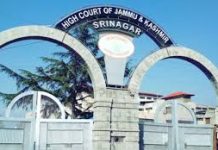 Higher education centres in India have been hogging media headlines for some time but mostly for wrong reasons. Students, instead of being in classrooms, are on the road, protesting against fee hike and police highhandedness to stifle the voice of dissent being raised on university campuses across the country.
Higher education centres in India have been hogging media headlines for some time but mostly for wrong reasons. Students, instead of being in classrooms, are on the road, protesting against fee hike and police highhandedness to stifle the voice of dissent being raised on university campuses across the country.
The causes for which they have risked their career include the demand for repealing the Citizenship Amendment Act, scrapping the idea of a National Register of Citizens in a country where the poor constitute the majority of the population and abandoning the move for the National Population Register by introducing controversial columns to acquire details about the people and their forefathers.
If the merciless beating up of students and their teachers by the police at Delhi’s Jawaharlal Nehru University for protesting against an unusual fee hike had its echo on university campuses all over the country, a similar dance of violence and destruction at Jamia Millia Islamia also evoked support from the student community all over the country and many premier universities abroad.
It first began with police personnel mercilessly beating up protesting Jamia Millia Islamia students on December 15, 2019. Their crime was they had raised slogans against the controversial Citizenship Amendment Act (CAA), considered discriminatory against Muslims. Even those in the main library building, busy with reading books, were not spared. The police first burst tear gas shells and then rained lathis on innocent students to force them to keep quiet over the move to change the basic and secular character of the Constitution.
The Jamia authorities claimed that the police personnel entered the university campus without their permission, which led to condemnation from different sections of society. The police did not spare even those in the campus mosque, including the imam, the man who leads daily prayers.
The Jamia administration described the police action as “unprovoked targeting of innocent students”. There was no provocation for the police to treat the students like criminals. The students denied that they indulged in the burning of buses and other vehicles. Their denial was supported by the videos relating to what happened at Jamia on that fateful December 15 evening. Yet over 125 students were arrested.
However, the police brutality could not dampen the spirit of the students, who continue to hold their peaceful protest outside the Jamia campus with the declaration that they will continue their anti-CAA and anti-NRC agitation till the discriminatory law is repealed and the fanciful NRC idea is dumped in the dustbin of history.
Surprisingly, no FIR was lodged in this connection against any police official till January 15 though the police action occurred on marching students and those at the campus on December 15 evening. On January 13 when over 100 students gheraoed the office of Vice-Chancellor Najma Akhtar, she assured them that the university administration would approach the court to get an FIR registered against the police “brutality”.
Interestingly, while the police lathi-charged harmless students at Jamia without bothering about getting the university authorities’ permission, it kept waiting at JNU for the Vice-Chancellor’s permission to take action against the goons, believed to be Akhil Bharatiya Vidyarthi Prishad (ABVP) members, who attacked students with iron rods, lathis and other such weapons on January 5. JNU Students Union President (JNUSU) Aishe Ghosh alleged, “Masked men repeatedly hammered my head with iron rods. There are videos of this.” She accused the university administration of colluding with the police in what happened at Sabarmati Hostel and elsewhere.
JNUSU general secretary Satish Chandra Yadav claimed that all this happened “because of a nexus between the police and the ABVP”. He further stated, “The police held a press conference hurriedly and named leftist organisations, but not once did they take the name of ABVP. They have based their findings on pictures that have gone viral, but what is the authenticity of these images. And why have pictures with ABVP activists not been considered?”
It is regrettable that JNU Vice-Chancellor M Jagadesh Kumar did not play a healthy role in the sad happenings at the prestigious university’s campus. It is difficult to believe that the goons who entered JNU campus armed with sticks, lathis and iron rods were helped by someone who wanted “to teach a lesson” to left-leaning students.
JNU is not an ordinary university. The violence at the JNU campus obviously owing to the failure of the university administration and the alleged complicity of the police evoked sympathy from students at many universities across the country who held demonstrations soon after the beating up of JNU students. The JNU attacks on students came soon after the police brutality in the case of Jamia students. And both incidents had their echoes at university campuses throughout the country. The result is that the students today are on a war path, little realising that this may endanger their academic future.
The incidents at Jamia encouraged students, with support from their fraternity at JNU, Delhi University and other universities in different parts of the country, to continue their protests against the CAA-NRC till their demands are met. Not only this; what happened at Jamia without any planning has, in fact, given birth to a major movement aimed at protecting the secular character of the Constitution.
Thus, what initially appeared to be an issue involving the Muslims and the government has taken the shape of a country-wide movement with the Central government and the BJP being on the one side and the rest of the country on the other. This is not good for the country, but who bothers about the nation when intentions are not pious?
The story takes one to Southeast Delhi’s Shaheen Bagh, which has somehow turned out to be a bigger symbol of anti-government protests mainly because of Jamia. Had there been no Jamia, there would have been no Shaheen Bagh. And any movement involving students has rarely been unsuccessful.
It is true that all that has been happening for over a month may ruin the career of many students, but they and their families may draw satisfaction that their role in fathering a movement has succeeded in turning a denominational problem into a major national drive against the government’s divisive idea to perpetuate its rule in the country.
letters@tehelka.com













